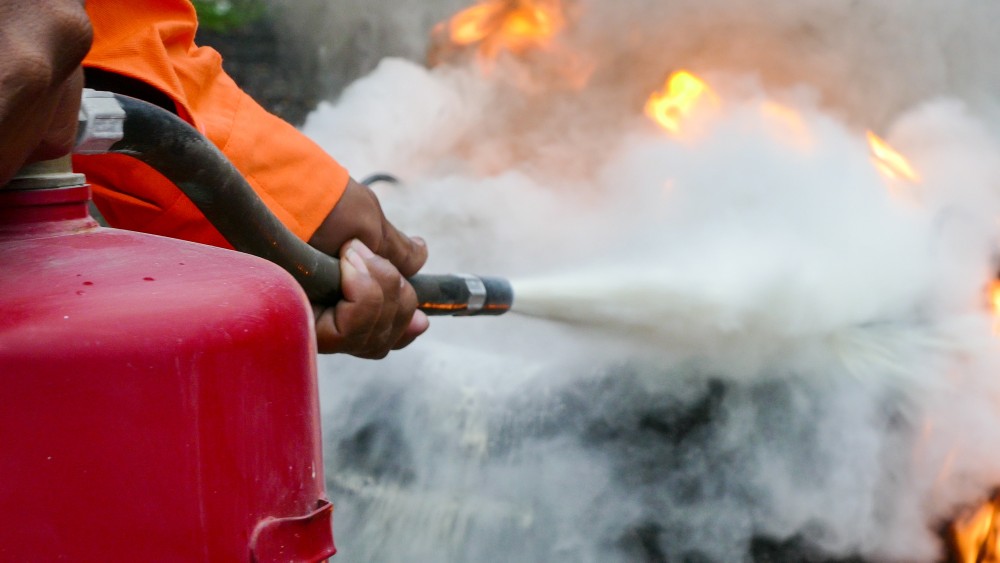October is Fire Safety Month! While it’s important to be safe and vigilant throughout the year, October is the month we are reminded of the easy, yet incredibly important things we can do to improve the fire safety of our homes, as well as our workplace fire safety programs. In honor of the month, we’re taking some time to highlight five fire safety tips you can complete, both at home and at work.
01. Check Smoke Detectors & Fire Alarms
Smoke detectors and fire alarms are our first defense when it comes to fire safety. Though most people are familiar with the single, combined device you place on the ceiling in your home, there are a variety of fire safety systems. They should be checked regularly, and October is a great time of the year to review your fire safety plans at home and at work.
At Home
All living spaces should have smoke detectors and fire alarms. Make sure you understand how your system or devices work, the appropriate testing schedule, as well as when to change batteries if needed.
Though it is becoming more popular for carbon monoxide alarms to be part of your smoke detector system, if you have a separate device, it’s best to test everything at the same time. In colder weather, houses have less ventilation, and the risk of carbon monoxide poisoning can be much higher. Knowing your alarms are functioning correctly can provide peace of mind and keep you safe.
At Work
Companies of any size should have a plan for testing and inspecting the smoke detector and fire alarm systems. These tasks may be performed by internal or external personnel. Your company’s fire protection program will provide details regarding who is responsible for the variety of tasks and the frequency they occur.
02. Inspect Fire Extinguishers
Another tool to have available in case of a fire is a fire extinguisher. Though a workplace often has different fire extinguishers than the ones you might have at home, both require inspection to ensure that they function properly.
Both At Home & At Work
The following items should be inspected whether you are at home or at work.
- Check the pressure gauge for rust or corrosion
- If the extinguisher is dirty, clean and dry it to prevent future corrosion
- Ensure the safety seal or tamper indicator is still intact
- Inspect the fire extinguisher nozzle to ensure it is clean and free of obstruction
- Tip the extinguisher upside down to loosen any compacted extinguishing agent
03. Know How to Use a Fire Extinguisher
Fire extinguishers are an incredibly powerful tool in fighting small fires when properly trained. There are a variety of types of fire extinguishers available based on the type of fire you may encounter. A grease fire needs to be handled differently than an electrical fire. Having the proper training to identify the size of the fire, the type of fire, and the type of extinguisher to be used is critical.
At Home
Even if it seems silly, all age-appropriate family members should be trained on how to use a fire extinguisher. Fire extinguishers are only effective if they are used properly. If an individual does not know how to pull the pin, aim the nozzle, squeeze the trigger and sweep at the base of the fire, it will not be effective.
Fire Safety Month is a great time to check out your local resources for training. You may be able to gather a small group of friends, family members, or neighbors to receive instruction from your local fire department. There are also a wealth of online resources available.
At Work
Training should be provided for those employees who may need to use a fire extinguisher in the workplace. This should include classroom and hands-on training in order to keep you safe and set you up for success. Follow your company’s fire safety program for the requirements regarding the use of fire extinguishers.
04. Review Your Fire Evacuation Plan
All buildings should have a fire evacuation plan. Whether it’s at home or at work, drills should take place, so everyone knows what to do and where to go.
At Home
Does your family have a fire escape plan?
If not, now is a good time to create one. Make sure each family member knows how to safely exit the home in the event of a fire and designate a meeting place for everyone to check in. It may be helpful to practice your escape plan from different rooms so all family members understand the importance and feel confident about how to evacuate quickly.
At Work
Most workplaces are required to have a documented fire plan in place. If your building has changed at all in the past year, be sure to adjust the evacuation plan accordingly.
A fire evacuation drill should be conducted as well. Designated check-in location(s) should be established and communicated to all employees. Review roles and responsibilities to ensure any additional safety measures are taken and all employees are accounted for.
05. Ensure Emergency Contact Information is Up-to-Date
Another important part of your fire safety program is to know who to call and where this information can be found.
At Home
Make sure fire department and emergency service numbers are clearly posted or saved on everyone’s phone. It can be helpful to list all of these numbers in a central location, such as the refrigerator. Be sure to include the home address as well, so no one has to search for it in the event of an emergency.
Every year, double-check that this information is still up-to-date. If there are secondary emergency contacts (like extended family or neighbors) to call in the event of an emergency, now is the time to verify those numbers as well.
At Work
Your workplace evacuation plan should list the numbers of the local fire department, emergency services, and any other internal contact requirements. It is also helpful to have the address of the building clearly posted so that in an emergency, your location can be quickly communicated to emergency services.
By focusing on fire safety in October, we can refresh ourselves on best practices, as well as build confidence in knowing how to best handle an intense situation. We don’t often think of training as something for the home, however, teaching all members of your family what to do in an emergency, especially a fire, could make all the difference.
No matter what month your company designates training in fire safety, make sure your team has the tools and the training they need to stay safe and react quickly in the event of a fire. Check out eSafety’s fire extinguisher safety course to get started.

